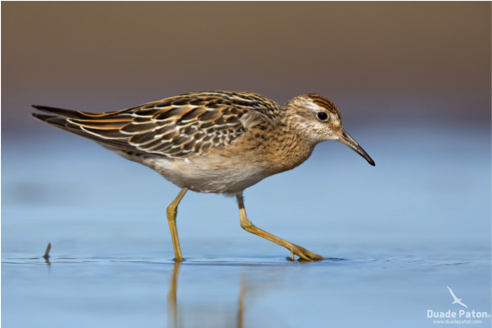Module 4:
How Do Birds Regulate Temperature?
In this lesson, students will be organising, presenting, analysing and interpreting data from a scatterplot they create. Students will be required to hypothesise the relationship between ‘back rest’ behaviour and temperature. Students will be using the information to make conclusions about the ‘back rest’ behaviour in the Sharp-Tailed Sandpiper species and will answer questions that relate to their analysis.
Summary
VCE Biology (2016-2020)
Unit 1, Area of Study 2, Outcome 2, VCE Biology Study Design
Key knowledge
Survival through adaptations and regulation
- The structural, physiological and behavioural adaptations that enhance an organism’s survival and enable life to exist in a wide range of environments
Key science skills
Analyse and evaluate data, methods and scientific models
- Process quantitative data using appropriate mathematical relationships and units
- Organise, present and interpret data using line graphs and calculations of mean
- Explain the merit of replicating procedures and the effects of samples sizes in obtaining reliable data
Duration

Student learning outcomes
At the completion of this lesson, students should be able to:
- Understand that adaptations enhance an organism’s survival
- Use secondary data to describe how temperature and climatic conditions can influence an animal’s behaviour
Teacher background information
Throughout this lesson, students will be analysing data from a scientific investigation. Students will use the data to answer a series of questions. The questions are scaffolded throughout this activity, which provides teachers with the opportunity to differentiate for their students. The secondary data is presented below. You can devise a way for your students to conduct an investigation using this data, or it can be used as a basis for a more open-ended analysis. If a guided inquiry is more desirable, the worksheet and analysis questions for this activity will provide a directed inquiry of data analysis for students. This data analysis is modelled around exam questions for students to practise data interpretation for their assessments, exams and Unit 3 & 4 exams.
Thermoregulation through bird beaks and bills is an adaptation birds have evolved to deal with the challenge of temperature change, to maintain a constant temperature of their internal environment. Species of birds have also developed a behavioural adaptation to deal with colder temperatures. When temperatures are cold, birds tuck their bill/beak into their plumage, this motion is known as ‘back rest’, and it is a way of conserving heat. Interestingly, in very hot temperatures, birds also exhibit the back rest behaviour, so they aren’t taking in extra heat from their external environment through their beak. Over the last 100-150 years, there has been an increase in beak sizes in some species, which is due to climate change. This information can be used to explore other climate issues, and how other organisms have adapted to climate change. The students will be completing this task individually, whilst the teacher moves around the classroom to assist the students. Students should attempt to practise questions individually before consulting their teacher or their peers. At the end of the task, the students will be concluding why the back rest behaviour is a behavioural adaptation. Students will be considering the change in morphology of developing larger beak and bill sizes over the last 100-150 years, and how this is attributed to climate change.
Teaching sequence
Overview
Activity 4.1 - Investigation Using Data to Observe Thermoregulatory Behaviour in Bird Species: Students will investigate the effect of temperature on the back rest behaviour in the Sharp-Tailed Sandpiper species.
Activities
Activity 4.1 - Investigation Using Data to Observe Thermoregulatory Behaviour in Bird Species (60 minutes)
Introduction
It is a common thought for individuals to have the conception that bird beaks are used for foraging, eating, enticing a mate, or perhaps even just a feature similar to hair, fingernails or toenails. The bird beak is non-insulated and is highly vascularised, making it efficient for heat transfer (Ryeland et al. 2017, p. 887). Interestingly, it has been discovered that birds use their bills or beaks to thermoregulate. In the warmer climates, such as environments closer to the equator, the bird beak sizes have adapted to be larger, this is because appendages lose heat. Having a larger beak in a warmer climate is an advantageous adaptation for birds to lose heat, as their bills/beaks are highly vascularised and can lose heat easily. This means birds will not have an increase in internal body temperature, when the temperature in the environment around them increases. For example, in the toucan, 60% of heat loss is from its large bill size when it is resting (Ryeland et al. 2017, p. 885). Contrastingly, in cooler climates, bird beaks are smaller, so the species can conserve heat. This has also been observed and recorded in altitude changes. Bird beak thermoregulation and adapting to the climate by having larger or smaller beaks, has been observed in many species such as penguins, grouse, terns, gulls, barbets and parrots. This is known as Allen’s Rule.
Teacher to show students video on Allen’s rule which relates to species of birds, who thermoregulate through their beak https://deakin.au.panopto.com/Panopto/Pages/Viewer.aspx?id=c5e4a3f6-b5ad-4c54-baf5-afe7012af672 (Lim, Deakin University 2015)
Thermoregulation through bird beaks and bills is an adaptation birds have evolved to deal with the challenge of temperature change, to maintain the temperature of their internal environment. Species of birds have also developed a behaviour where they tuck their bill/beak into their plumage, this motion is known as ‘back rest’. The ‘back rest’ motion is what will be investigated throughout this activity.
Background Information

Sharp-tailed Sandpipers are migratory birds which live on shores. They breed in Siberia and migrate a long way south, to Australia for their non-breeding season, from September to February (Adams, Museum Victoria 2016). The Sharp-tailed Sandpipers are found all throughout Australia during their migratory season. Sharp-tailed Sandpipers live in shallow inland freshwater wetlands, mudflats, saltmarshes, mangroves, rocky shores and beach
(Adams, Museum Victoria 2016). This species exhibits the back rest motion, by tucking their thin beaks behind their plumage. Data on the frequency of the Sharp-tailed Sandpiper exhibiting this behaviour, and the temperature when this behaviour occurs is shown in the table below. Data are sourced from a published paper by Ryeland, Weston & Symonds (2017) Functional Ecology 31: 885-893
Purpose
- To observe the frequency of the back rest behaviour in the Sharp Tailed Sandpiper species (Calidris acuminata)
- To consider why this behaviour is exhibited
Materials:
Next module: Linking Adaptation Concepts
 Contemporary VCE Biology
Contemporary VCE Biology


